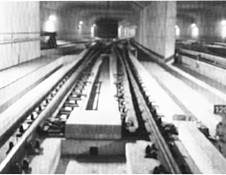 |
Rotterdam Metro
Tunnels I'm sorry ... I
have not been in yet. I don't know how (and when) to get
in them. I'm still dreaming of walking through the metro
tunnels, with or maybe without permission. But I've
collected some relevant information. You can find the
following subjects here:
|
| There are two metro lines in Rotterdam. Every day 300.000 people
travel with the Rotterdam metro. The "ERASMUS" runs
approximately North-South and dives under the river
twice. It starts at the Central Station and ends at
Spijkenisse. The section Central Station -
Wilhelminaplein runs underground. The rest runs on
above-ground viaducts.
Here you're looking south from
metro-station Slinge.
|
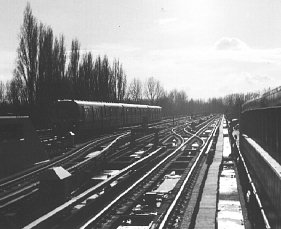 |
| The "CALAND" runs
approximately East-West. It starts at the Marconiplein
and ends at Capelle a/d IJssel, Ommoord or Zevenkamp. The
section Marconiplein - Kralingse Zoon runs underground.
The rest runs at the road-level. Here you're looking west from
metro-station De Terp.
There is also an underground
metro-line ("de verbindingsboog") between Blaak
and Leuvehaven. This one connects the two metro-lines. It
does not carry normal traffic. It is used to shuffle cars
between the lines and it's there for emergency
situations.
|
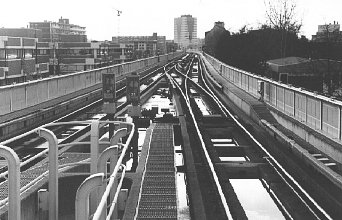 |
Interesting
features of some stations - legal
| Erasmus (Centra
Station - Spijkenisse) |
Caland
(Marconiplein - Capelle) |
- Stadhuis - water flowing
along the vertical glass panels
- Wilhelminaplein - the
newest station, it has a lot of marble and a
sloping platform
- Rijnhaven - great view of
the river
- Maashaven - large grain
silo's, great view of the harbour
- .....
|
- Blaak - connection to the
train tunnel, medieval castle in the tunnel,
climable steel arch above the station - pictures
are shown in the buildering section and the
underground section of this website
- Oostplein - glass windows
in the floor (you can see the tops of the cars),
modern art gallery, metro museum
- Gerdesiaweg - four
ventilation shafts near the end of the platform
- Kralingse Zoom - the
permanent blue light in the tunnel shows where
the emergency exit is
- .....
|
- There are atomic fall out
shelters under several metro-stations. All
together they can house 52.000 people
- .....
|
Security -
warning: actual entry is illegal and dangerous!
All of the stations are guarded by
closed-circuit video cameras connected to security stations.
There are 7 security stations that are spread approximately every
6 stations. They are always manned by one security guard with 10
monitors. The cameras show the entrances, exits and an overview
of the platforms. No tunnel views. The camera's are always active
during business-hours. You can see the camera-pictures by looking
at the security monitors through the windows of the security
rooms. These are situated at the stations:
- Capelsebrug - Slotlaan, Capelle
Centrum, De Terp and itself
- Oostplein - this one watches:
Chuchillplein, Blaak and itself
- Eendrachtsplein - this one watches:
Marconiplein, Delfshaven, Coolhaven, Dijkzicht and itself
- .....
There are 600 camera's in the 42 metro
stations. In tootal there are seventy monitors in the security
stations. Every camera-view is shown for 30 seconds. That means
that a cycle through all the camera's takes 4 to 6 minutes.
During business-hours stations are
guarded by mobile teams of 2 guards who also check the tickets of
the passengers while they're on the train. I don't know what
happens during the quiet hours.
CALAND: The first trains leave
Marconiplein at 5:44 and arrive at Alexander at 6:14. The last
trains leave Marconiplein at 0:46 and arrive Capelsebrug at 1:00.
So that leaves a window of opportunity between 1:00 and 5:00.
ERASMUS: The first trains leave Central
Station at 5:42 and arrive at De Akkers at 6:14. The first trains
leave Slinge at 5:25 and arrive at Central Station at 5:39. The
last trains leave Central Station at 0:43 and arrive at Slinge
0:56. The last trains leave De Akkers 0:19 and arrive at Central
Station 0:50. So that also leaves a window of opportunity between
1:00 and 5:00.
The small "Entry forbidden"
gates do not lead to alarms.
There is a steel walkway running through
the middle and along the sides of the metro-tunnels. In most
places there is enough room to let the trains run past you. I
don't know how severe the wind-drag would be if that happened.
The electrified "third rail"
carries 750 volts and can be fatal. Fortunately it is covered by
an insulating sheath on top and along the sides. So the risk of
elecrocution is relatively small. The collector uses the
under-side of the rail to get it's current. The rail is situated
in the middle, between the rails so if you use the walkway you
don't even come near it.
The platforms are cleaned every day, but
not the tunnels. There is no periodic cleaning or maintenence
inside.
There are no infrared detectors or alarm
systems in the tunnels.
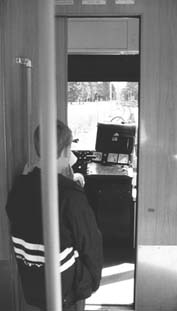 |
Reconnaisance - legal The metro schedules are available free of
chrge at every station.
You can see inside the tunnels
by waiting untill a driver opens his door during hot
weather. Then you can also look at the monitor on the
right side of the cabin. This monitor shows the platforms
while the car is entering and leaving a station. The
platform-camera is connected to a monitor in the driver's
cabin through a radio link. He uses it to check if all
the people have got in and out of the train. Something
like a rear-view mirror. These are disconnected when the
train leaves the platform.
|
 |
Points of
entry - illegal
| The most promising entry point
is station Zalmplaat. It is the safest and the most
adventurous. It lies at the outskirts of Rotterdam. The
above-ground rails dive under the harbour and exit again
at the other side. The tunnel is easily accessible, as
far as I can see no camera's. Could there be sensors in
the tunnel? You have to walk 200m along the walkway
beside the tracks to reach the mouth of the tunnel.
There's a small room here that might be useful as a
hiding place and a springboard for the real inside of the
tunnel. Graffiti abounds. Probably I would have to take a
friend in case we meet some strange characters down here. In January 2000 Last weekend a Metro
carriage lost both motors and was derailed in this
tunnel. When the rescue team arrived they found the
carriage empty. The passengers had smashed a window and
had walked out through the metro-tunnel. Yes, this
gorgeous, long, metro-tunnel under the river (near
Zalmplaat). What a lucky bastards!
|
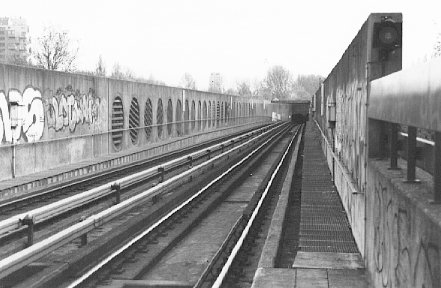 |
The ventilation shafts at Gerdesiaweg
might be another entry point. Just at the end of the platform
there are ventilations shafts. Once you're inside you are
invisible from the tunnel and from the platform. There is not
much to see there and it leads nowhere but it would be a first
step. This shaft is only accessible during operational hours. The
trick would be to get in between two metro-car-arrivals unnoticed
by camera's and passengers. I've thought that I could try this
plot:
- I drop a probable object through
the grid of the ventilation shaft from outside (for
example: the lens-cap of my camera). Then I go inside the
shaft to collect it (and explore a bit and take
pictures). If someone sees me I tell them that: "I
was taking pictures through the grid (for my website of
strange places in Rotterdam) and dropped my lens-cap. Yes
ofcourse I know it's dangerous but I really wanted it
back badly. So I had to go inside. I'll never do it
again."
In fact every station that connects
ground-level with the tunnel-level might be a good entry point:
- Wilhelminaplein - but lots of
camera's
- Kralingse Zoom
- .....
I received several hints from readers
but I don't know if they're useful:
- Trying to get locked inside a
station after business hours.
- Hiding in one of the elevators.
- It is rumored that entrances exist
that are not obvious to the public and are known to only
a few people.
Where are
the other explorers?
I'm certain that lots of other people
have been in the metro tunnels illegally. There is a lot of
graffiti in the tunnels. No large/complex graffiti there, only
tags. So I assume the writers never stay long. I have tried to
make contact with the writers but all my attempts have failed.
- Yet another writer tells me:
Hi,
I was a bit surprised to see that there is someone who
also shares the passion for the rotterdam subwaytunnels,
and I can help you, or each other.
I know a lot about the tunnels and the system, 2 years
ago I entered the tunnel at kralingse zoom, and walked in
for about a hundred meters, but was too scared
to walk on.
The reason for my fascination is that I am a graffiti
writer, and now that I sent you an E-mail, I hope
you don't spread my real name around. I have a lot of
contacts with other writers who entered the tunnels, but
they are very scretive about it, even after years of
writing together.
I could tell everything I know, but that wouldn't fit
in one E-mail. What I.'m trying to say here is
that for the past 5 years that I have been writing
in rotterdam, I have done a subwaycar on the yard, walked
into the tunnels, but I have never spent there enough
time to do my thing. I'm there for graffiti, and you for
the experience. I have almost figured it out. If
you are interested, please send me an E-mail concerning
this subject , this amount of information doesn't
come across you everyday.
- TERROR010 writes: You can also
enter the tunnels at wilhelminaplein, next to the old
train where a junkie sleeps in... they are building
something there and now it is way too easy to get in just
look around and you'll see - also i want to tell you i
entered the tunnels at the exit betweet capelse brug -
voorschoterlaan because one of the doors is open... it is
also very easy to enter there when you climb over the
wall opposite capelse brug, you can walk to the exit
within 10 / 15 minutes and you can open the doors from
the inside... i also want to notice you i know a very
strange villa in Rotterdam, i've been there the first
time like 2 years ago, when i walked into the garden i
noticed a car as i looked in the car i saw some folders
and the door was open. i opened the door and the light of
the inside of the car was still working, so it wouldn't
be there long. when i looked inside the place i saw a
dirty mess and you can see it is old.. there's a bed
standing in the living room.
- i went away, came back some months later and still
everything was there, the open car but hey... there
folders in there from a few weeks ago... so it seems
someone was in the car.. but who... i tried to get in the
place but failed, then i went to the otherside of the
house and i broke a window so i could see if it was fixed
the next time i arrived, i looked there a few weeks ago
and still the car is there with his door open, the window
is broken and still the same mess at the inside of the
building... if you want i'll see what the adress of the
house is for futher investigation .. hehe :)
- I met a graffiti crew last year and
they claimed to know the guys, but didn't want to give me
their names.
- I know a film-maker who knows the
skating-scene and some skaters have connections in the
graffiti scene. He inquired for me. The writers were shy.
They had already taken a lot of people inside the
tunnels. The RET security people were getting more eager
to catch them. And once they were filmed and their faces
were recognizable. This had bad consequences for one
member of their crew.
- Then I got this e-mail, but I have
severe doubts about it's authenticity and
trustworthiness:
- I'm one of those guys thats sprays
paint just anywhere I can. Especially in in the
subway-tunnels in Rotterdam Just a reminder for that for
that other guy in Rotterdam who wants to explore the
underground net..Don't !!! 3 years ago the RET (Metro
Company) placed some infared detectors. A crew of "
Naziguards " will enter the tunnel about 20 minutes
from the detection-alert. They don't treat you nicely...I
know Maybe this could be a rush for some people, get
in...spray some paint .... en get the hell out !! I'm not
saying it lightly when I say they'll smash you up real
good !!! One could see some fun in this.......but then
again, better not if you want to see daylight again.
Explore @ Rotterdam (not by B.Gates)
- Graffiti informatie van < anoniem >
Ik ben zelf een actieve graffitispuiter
en ken een hele zooi mensen die om de zoveel tijd tunnels
bezoeken,waar treinen of metros doorheen rijden. Het is
inderdaad erg lastig om contact te krijgen met deze
groep....vaak is er geen vertrouwen of hebben we gewoon
iets van:lastig om iemand mee te nemen of je kennis te
delen met een non-graffiti persoon.
Ik kan je wel zeggen dat je bv. in de graffitishop in
Rotterdam films kan kopen waarin de metrotunnels van
Parijs worden geinfiltreerd.Gaan ze met betonschaar
gewapend gaten knippen in roosters in de stoep,dalen van
trappen af en komen in duistere plekken terecht waar de
metros overdag en in de nacht opgesteld staan(in
Amsterdam gebeurt dit de laatste tijd ook veel,maar dan
spuiten ze de stationsmuren). Titels:"DIRTY
HANDZ" 1 & 2.
Verder heb ik nog wel een goed
verhaal voor je.... Er is een urban legend in de
Amsterdamse graff-scene waarin een bepaalde groep
spuiters uit midden jaren ´80 de atoomschuilkelder onder
de Amsterdamse metro binnen is gegaan door het
ontvreemden van een sleutel uit een GVB gebouw. In de
ruime kelder aangeland werd deze voorzien van een nieuwe
laag verf en werd er met meer vrienden een feest
gegeven... Het is zelfs zo erg dat het verhaal gaat dat
deze kelder bereikt kan/kon worden door de sleutel in de
"gewone" lift van het metrostation Centraal in
het paneel te steken en een verdieping lager te gaan dan
staat aangegeven.(jaja!)
- Ik kwam aan je pagina door een link op een
graffitipagina:dutchdamage.com, waarop iemand de
verlaten/nooit afgemaakte metrotunnels in Charleroi heeft
bezocht en daar een supergraffitiparadijs aantrof. Mijn
eigen infiltraties houden op bij een deel van de
Schipholtunnel,ik was erg paranoide door de geluiden van
de aankomende treinen en de hele scenery.. Ik zou je wel
het rangeerterrein van Rotterdam aan willen bevelen,maar
daar ben je vast al geweest....richting Schiedam is er
een leuk terrein waar je niet mag komen. Oke,dat was het
weer....veel succes verder met infiltreren.
- ik heb getracht meer info te
verzamelen maar bijna niemand kan met echte
"goede" details komen. Het enige dat ik ben
opgeschoten,is dat het misschien om een nooit afgebouwd
gedeelte van een metrolijn zou gaan,dat onder het station
Weesperplein is gebouwd. Wellicht is dat een heel ander
verhaal,maar ja....duidelijker wordt het niet echt.
- Graffiti informatie van "de
handhaver" dehandhaver@hotmail.com
Tectyl wordt vaak ingezet als
"geheim wapen". Spuitbussen als Valvoline's
Bodysafe of Cover's all zijn bedoeld om de onderkant van
de auto mee in te teren, maar bleken uiterst geschikt als
zwart/donkerbruin in illegale pieces op bijvoorbeeld
zuigbeton. Verf trekt in het beton, en is dus niet
toereikend als je het beton niet eerst voorbehandeld met
latex. Bovendien is de tectyl (ook wel "teer"
genoemd) erg lastig te verwijderen, waardoor de piece
langer blijft staan. Razend populair spul dus! Vroeger
nog te koop bij de ordinaire benzinepomp, maar doordat ze
erg veel gestolen werden inmiddels niet meer, vandaar....
en kleurloos? Misschien zijn er meerdere soorten, maar
die ik bedoel is zwartbruin.
Ik vergat daarnet nog te
vermelden dat er in graffitikringen ook video's worden
gemaakt die in je presentatie niet hadden misstaan. Ik
moet erbij zeggen dat de videobanden wel erg in het teken
van vandalisme staan, maar voor iemand als jij die een zo
breed mogelijk beeld van "urban exploration"
nastreeft is dit wellicht interressant.
De franse videoserie "dirty
hands" toont groepen die de metrobuizen van Parijs
ingaan op zoek naar hun weerloze prooi; slapende
metrostellen. Via luiken, tunnebuizen en over hekken
bereiken ze hun doel. Vervolgens live-actieshots van
gebivakmutste lieden die treinstellen onderspuiten.
Kwaliteit van het camerawerk is goed, maar film is
bijzonder "explicit".
De klassieker: De NewYorkse
documentairemaker Henry Chalfant maakte in 1984 de
inmiddels legendarische documentaire
"Stylewars" over hip-hop cultuur in NY. De film
toont naast rap en breakdancing ook jongens die de
tunnels verkennen. De wijze waarop zij de metrobuizen
ingaan is belachelijk simpel. De film zorgde na
uitzending door de NOS in '85 voor de geboorte van
graffiti in Nederland. Deze docu is alom erkend als de
beste in zijn soort, en wordt nog steeds heel af en toe
uitgezonden. Iedere graffitischrijver heeft hem thuis in
de kast. Mocht je nieuwsgierig zijn geworden, de films
zijn te koop in bijvoorbeeld "urban unit" aan
de nieuwe Binnenweg in Rotterdam, en heel soms vind je
"stylewars" in de verhuur bij de beter
gesorteerde videotheek.
P.S., zag gister voor het eerst
"Jackass"
Construction
of the new Benelux line - Recent pictures
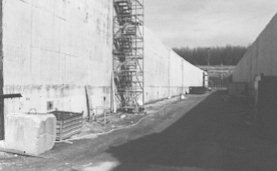
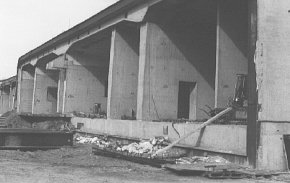
The Benelux-line is under construction
at the moment. It will be 11.8 km long when it is finished in
2002. It will run on viaducts (6.9 km), tunnels under land (3.2
km) and one tunnel under the river (1,7 km). It costs
1.600.000.000 guilders.
I have visited the building site last
year during a (legal) excursion. We were shown the sections of
the tunnel that will run under the river. At the moment they are
actually lying on the river bottom already.
On the right you can see the different
tunnels that run through the section.
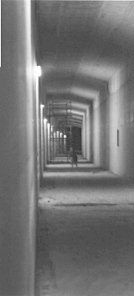

Here you can see the inside of the
tunnel. The first picture shows the length of the segment. The
other picture shows the doors that connect the emergency tunnels
with the regular tunnels.
| Construction
- Historic pictures 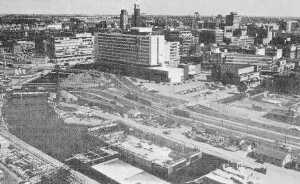
|
Imagine - I got these pictures
from Johnathan Littell from America. He found them in
some old publication. The
metro during it's construction. You can see the
Hilton-hotel and the tower of the town-hall. The chaotic
terrain in the foreground is the construction pit. They
used a classic way of building city-tunnels: you dig a
pit, build the tunnel in the pit and cover the whole
thing again. In the meantime the normal traffic is
subject to anarchy and improvisation.
|
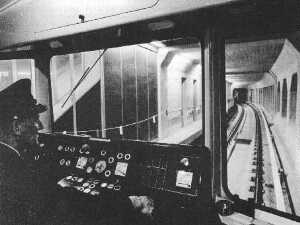 |
A view inside the metro tunnel.
Nowadays they don't look so clean anymore. The metro car
is 35 years old and some of them are still in use today.
They will be decommissioned this or next year. |
Metro verkenners in de jaren 80
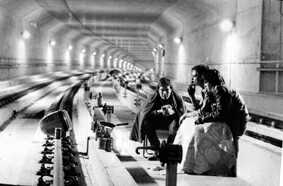
Syp Fiets: Tijdens de bouw van de oost
west metrolijn in rotterdam - ergens in de jaren 80 - ben
ik samen met een vriend een keer van station coolhaven tot
station blaak gelopen. we deden ons voor als een soort van
ingenieurs of opzichters, we hadden allebei een bouwhelmpje op en
niemand legde ons toen een strobreed in de weg.
later hebben wij de lokatie van de in aanbouw zijnde
metrotunnel nog gebruikt als dekor voor ee aantal foto's voor een
boekje wat wij toen schreven. in dat boek was de ns-spoortunnel -
die toen alleen nog op papier bestond - een toevluchtsoord voor
daklozen in het jaar 2005 geworden. zoek in de bieb maar naar
"het luchtspoor". het boek is uitverkocht ik zal die
foto's wel eens inscannen en naar je toemailen. zo zie je dat
urban adventure al een zoektocht uit een lang verleden is. wie
wil er niet zien wat achter het bordje verboden toegang ligt.
*** Hierbij de beloofde foto van de metrotunnel te rotterdam.
De foto is genomen tijdens de bouw van de tunnel, begin jaren
80(?), ergens tussen station eendrachtsplein en churchilplein,
kijken in de oostelijke richting. de foto is later in een door
ons geschreven boekje over Het Luchtspoor (=ook de title)
gebruikt. Helaas uitverkoop, nog wel in de gem. bieb.
*** en succes met je webzine, ik kijk regelmatig naar wat
nieuws --- ps ben je al op de hoge heeren of de hoge erasmus
geweest, ik zie die gebouwen groeien maar als vijftiger kan ik al
die trappen niet meer op.
Atoomschuilkelders in de metro
Denk je dat je ook de atoomschuilkelders in de metro kunt
bezoeken (als verzoeknummer) er zijn er heel wat en zo ook onder
het Dijkzicht ziekenhuis heb ik gehoord. Maar ook in Den Haag is
er natuurlijk heel veel gegraven om zulke plekken te maken, ik
weet dat uit ervaring en was vaak verbaasd over de enorme
hoeveelheid vrachtwagens die er reden op verschillende
bouwlocaties (werkte toen als chauffeur in het centrum van Den
Haag). Ik heb zelf eens de kelder bezocht onder het Leyenburg
ziekenhuis, waar ik met stomheid was geslagen over de enorme
capaciteit die zulke "onderkomens" hebben te bieden,
eigenlijk luguber als je er goed over nadenkt. Alhoewel die boel
wel op slot zal zitten denk ik en daardoor misschien moeilijk
toegangkelijk is.
Nou ja hoe dan ook veel succes met je nieuwe avonturen ik
wacht met spanning je reactie af ik hoop dat je me "up to
date" wilt/kunt houden.
vr. gr. Wouter van Veldhuizen - wveldhui@kabelfoon.nl
Go to: List of
underground place, Urban Adventure
Home
© 1998, 2000 Petr Kazil - Updated and
revised 1 March 2000












